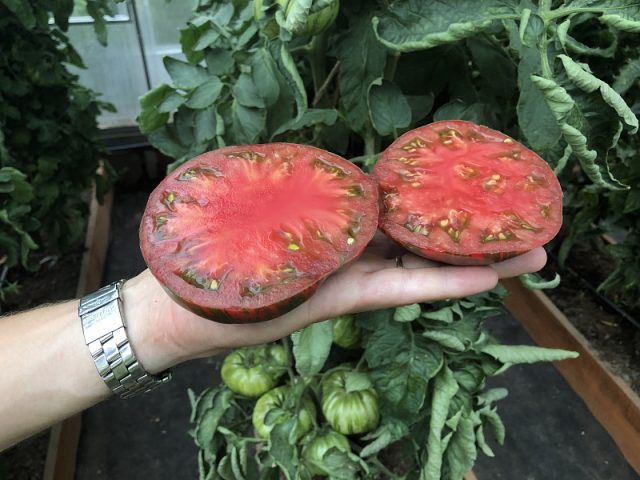Content
Vegetable salad is a favorite dish in the summer heat, but it won’t be as tasty without tomatoes. Chocolate stripes, or Tomato Striped chocolate, will add originality and piquancy to the dish. The unpretentious plant produces a bountiful harvest, which allows you to enjoy the fruits fresh or canned.
Description of the tomato variety Striped chocolate
In 2010, American breeders, including J. Seigel, crossed two species - Shimmeig Creg and pink beefsteak. The result was called “Striped Chocolate” due to the appearance of the fruit. The tomato has not yet been included in the State Register of Russia, but has already spread throughout the country.
Manufacturers give the following description of the Striped Chocolate tomato variety: a plant of an indeterminate type of development, grows up to 1.5 m in open ground and up to 2 m in greenhouse conditions. The Striped Chocolate variety has a thick, powerful main stem with moderate volume of foliage. The strong root system is branched and grows in a horizontal plane.
The leaf blade is medium in size and has clearly defined wrinkles.The color of the leaves is dark green, can fade under ultraviolet rays, the foliage does not have fluff. Inflorescences are formed above the 9th leaf, then every 3. They are of the usual type, each can set 5 - 6 large fruits. Grow tomatoes with 1 or 2 stems.
Description of the striped chocolate tomato: a mid-season variety, the fruits begin to ripen on the 100th – 110th day. The countdown begins from the moment the first shoots appear. The duration of fruiting is good - you can harvest until the last days of September; The fruits ripen together and abundantly. Most tomatoes are marketable in appearance and size.
Brief description and taste of the fruit
Tomatoes belong to the maxi category with an average diameter of 15 cm. Most of the harvest is 500 - 600g, but there are specimens up to 1 kg. The fruits are round in shape, flattened in the lower and upper parts. Features of the variety are the presence of stripes on the surface.
The pulp is dense, but not watery, and has a dark color. Inside there are 8 spacious chambers with a small number of fairly large seeds. It’s not for nothing that producers call the Striped Chocolate variety beef tomato: these are really large tomatoes with a lot of juicy pulp.
The technically mature fruit is red or burgundy in color with dark red or green stripes evenly distributed over the surface. The peel is dense and shiny. Tomato Striped chocolate is consumed fresh, which allows you to feel its pronounced aroma. The fruits taste sweetish, with a piquant sourness.
The variety is used for preparing salads, preserves, or grown for sale. However, it is not suitable for making juice or whole-fruit canning. Green tomatoes can also be rolled into glass jars with seasonings.
Characteristics of tomatoes Striped chocolate
From 10 to 16 kg of large and medium-sized fruits are collected per square meter of area. Fruiting in greenhouse conditions begins in June, in open ground - in July, and ends in mid-September. In some particularly warm areas, tomato growth can be observed until the end of the month.
Tomato yield is affected by:
- illumination of the landing site;
- fertilizer balance;
- regularity of feeding;
- sufficient soil moisture;
- timely loosening and weeding;
- soil fertility.
The plant is immune to viral diseases; only isolated cases of infection have been recorded. Pests don't like the taste of new tomatoes, so they prefer other varieties. In the description of the Striped Chocolate tomato, you can find a mention of late blight, but most often the plant resists it well.
Pros and cons of the variety
Tomato Striped Chocolate appealed to connoisseurs of original products. Ease of care and cultivation allowed the variety to become popular among ordinary gardeners. He was loved for other virtues:
- resistance to diseases and pests;
- long-term fruiting if agricultural practices are followed;
- original taste;
- unique aroma;
- high, stable yield;
- marketable condition;
- predominance of large fruits;
- beautiful colors.
As a disadvantage of Striped Chocolate, gardeners note that at elevated temperatures the fruits crack, which is why they then begin to rot. This also includes the need to tie the bushes to strong supports that do not always support the masses. The difficulty of transportation is also a disadvantage.
Rules for planting and care
In order for the Striped Chocolate tomato variety to exhibit maximum characteristics, you need to put in a little effort. Caring for the plant is easy. To do this you need:
- loosen the ground;
- weed;
- fertilize;
- pinch;
- dive.
Sowing seeds for seedlings
Preparation of seed material begins in March if the plant is intended for greenhouse conditions or in April for open ground. Containers for seedlings are disinfected with boiling water, a weak solution of manganese, or washed with soapy water. Striped chocolate tomato seeds are checked for germination by soaking in warm water for 10 - 15 minutes. and deleting pop-up ones.
To make the Striped Chocolate tomato rise faster, it is recommended to soak the planting material in a growth stimulator, following the manufacturer’s instructions. A mixture of soil from the site, sand, peat in equal parts is poured into a small container and, having made holes with a finger, seeds are planted at the rate of 2 - 3 pieces. by 1 cm.
All this is sprinkled with peat, covered with a transparent material - it can be glass, cling film or regular film. The containers are sent to a warm place with an air temperature of 25 degrees.
After 6 - 8 days, when the sprouts hatch, the room temperature is reduced to 18 - 20 degrees. The film or glass must be removed, allowing air access to the soil. Choose a sunny place for young tomatoes. Picking is carried out no earlier than 2 - 3 full-fledged leaves appear on the Striped Chocolate.
Transplanting seedlings
Young shoots are planted in open ground in June, and in a greenhouse in early May. A week before transplanting, the seedlings are hardened off so that they continue to grow well. To do this, the containers are taken outside, increasing the time every day. In order for the Striped Chocolate tomato variety to be well accepted, wait until the soil warms up to 15 - 16 degrees.
Choose a seat that is illuminated, but without drafts or direct sunlight. It is ideal if the shadow of a bush or small tree falls on the seedlings. After planting Striped Chocolate in the ground, it is recommended to cover it with film for the first week.
In open ground, leave 50 cm between holes, in a greenhouse - 60 cm. Per 1 sq. m. in greenhouse conditions, 2 - 3 plants are planted, in open ground - 4. Maintaining distance will allow the plant to grow. This will also simplify the implementation of agricultural activities, such as weeding, loosening, and fertilizing.
Tomato care
It is recommended to carry out pinching only in greenhouse growth conditions to form the main stem. To do this, every 2 weeks, small shoots that have not reached a length of 4 cm are removed. In open ground, the tomato does not need pinching. According to reviews, the Striped Chocolate tomato variety looks especially impressive on the table; the photo clearly shows the unique striped color of the fruit, thanks to which the fruit is difficult to confuse with other varieties.
Tall tomatoes must be tied up using only synthetic materials. For this variety, it is recommended to regularly apply mixed fertilizers, alternating organic and mineral. This can be rotted manure, wood ash, potassium and phosphorus compounds.Nitrogen fertilizers do not need to be used: the variety bears large fruits even without them.
Mulching the soil around the tomato stem will help prevent pests from entering the bush. This is a kind of barrier that earthly species of parasites cannot overcome. It is recommended to water the seedlings with water at room temperature 3 times a week in the evening, and loosen the soil the next morning.
Conclusion
Tomato Striped chocolate tolerates minor temperature changes well, loves bright places, and is undemanding to the composition of the soil. Fertilizers increase productivity, and regular watering affects the taste and size of the fruit. The variety is suitable for fresh consumption, cooking, canning, and sale.













